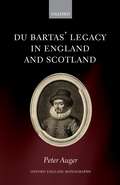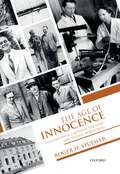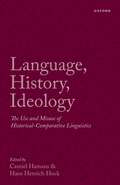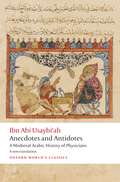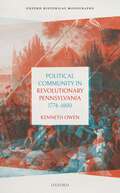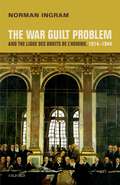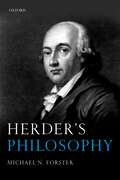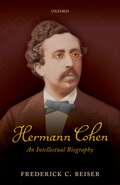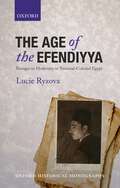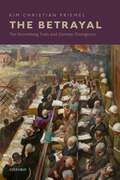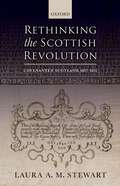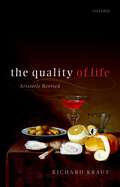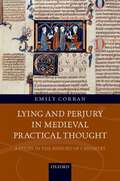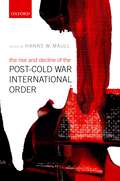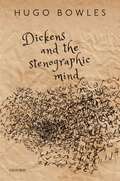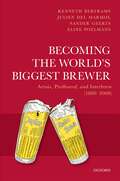- Table View
- List View
Du Bartas' Legacy in England and Scotland (Oxford English Monographs)
by Peter AugerGuillaume de Saluste Du Bartas was the most popular and widely-imitated poet in sixteenth- and seventeenth-century England and Scotland. C. S. Lewis felt that a reconsideration of his works' British reception was 'long overdue' back in the 1950s, and this study finally provides the first comprehensive account of how English-speaking authors read, translated, imitated, and eventually discarded Du Bartas' model for Protestant poetry. The first part shows that Du Bartas' friendship with James VI and I was key to his later popularity. Du Bartas' poetry symbolized a transnational Protestant literary culture in Huguenot France and Britain. Through James' intervention, Scottish literary tastes had a significant impact in England. Later chapters assess how Sidney, Spenser, Milton, and many other poets justified writing poetic fictions in reaction to Du Bartas' austere emphasis on scriptural truth. These chapters give equal attention to how Du Bartas' example offered a route into original verse composition for male and female poets across the literate population. Du Bartas' Legacy in England and Scotland responds to recent developments in transnational and translation studies, the history of reading, women's writing, religious literature, and manuscript studies. It argues that Du Bartas' legacy deserves far greater prominence than it has previously received because it offers a richer, more democratic, and more accurate view of sixteenth- and seventeenth-century English, Scottish, and French literature and religious culture.
Du Bartas' Legacy in England and Scotland (Oxford English Monographs)
by Peter AugerGuillaume de Saluste Du Bartas was the most popular and widely-imitated poet in sixteenth- and seventeenth-century England and Scotland. C. S. Lewis felt that a reconsideration of his works' British reception was 'long overdue' back in the 1950s, and this study finally provides the first comprehensive account of how English-speaking authors read, translated, imitated, and eventually discarded Du Bartas' model for Protestant poetry. The first part shows that Du Bartas' friendship with James VI and I was key to his later popularity. Du Bartas' poetry symbolized a transnational Protestant literary culture in Huguenot France and Britain. Through James' intervention, Scottish literary tastes had a significant impact in England. Later chapters assess how Sidney, Spenser, Milton, and many other poets justified writing poetic fictions in reaction to Du Bartas' austere emphasis on scriptural truth. These chapters give equal attention to how Du Bartas' example offered a route into original verse composition for male and female poets across the literate population. Du Bartas' Legacy in England and Scotland responds to recent developments in transnational and translation studies, the history of reading, women's writing, religious literature, and manuscript studies. It argues that Du Bartas' legacy deserves far greater prominence than it has previously received because it offers a richer, more democratic, and more accurate view of sixteenth- and seventeenth-century English, Scottish, and French literature and religious culture.
The Age of Innocence: Nuclear Physics between the First and Second World Wars
by Roger H. StuewerThe two decades between the first and second world wars saw the emergence of nuclear physics as the dominant field of experimental and theoretical physics, owing to the work of an international cast of gifted physicists. Prominent among them were Ernest Rutherford, George Gamow, the husband and wife team of Frédéric and Irène Joliot-Curie, John Cockcroft and Ernest Walton, Gregory Breit and Eugene Wigner, Lise Meitner and Otto Robert Frisch, the brash Ernest Lawrence, the prodigious Enrico Fermi, and the incomparable Niels Bohr. Their experimental and theoretical work arose from a quest to understand nuclear phenomena; it was not motivated by a desire to find a practical application for nuclear energy. In this sense, these physicists lived in an 'Age of Innocence'. They did not, however, live in isolation. Their research reflected their idiosyncratic personalities; it was shaped by the physical and intellectual environments of the countries and institutions in which they worked. It was also buffeted by the political upheavals after the Great War: the punitive postwar treaties, the runaway inflation in Germany and Austria, the Great Depression, and the intellectual migration from Germany and later from Austria and Italy. Their pioneering experimental and theoretical achievements in the interwar period therefore are set within their personal, institutional, and political contexts. Both domains and their mutual influences are conveyed by quotations from autobiographies, biographies, recollections, interviews, correspondence, and other writings of physicists and historians.
Language, History, Ideology: The Use and Misuse of Historical-Comparative Linguistics
This volume presents twelve in-depth case studies that critically examine the ways in which historical linguistics and language change interact with ideology. These varying interactions have been present since the birth of historical-comparative linguistics as a field of study. Work in historical linguistics may be appropriated or rejected for ideological reasons, most notably in the debates surrounding the Indo-European homeland; it can also by influenced by ideological biases, as in the 'alternative' histories that have been proposed for Moldovan and Maltese. The development of linguistically-defined nation states may itself fuel linguistic change, for instance through the suppression of minority languages or the division of existing languages to mirror political divisions, as occurred in the Balkans; or it may lead to the formulation of pseudo-histories designed to give a nation a more prestigious past. The book will be of interest not only to historical linguists but also to anthropologists, historians, and all those interested in language policy.
Anecdotes and Antidotes: A Medieval Arabic History of Physicians (Oxford World's Classics)
by Ibn Abi Usaybi'ahTo my knowledge...no one...has ever written a comprehensive book dealing with physicians through the ages and recounting their history in a coherent fashion. So wrote Syrian physician Ibn Abi Usaybi'ah, circa 1243, as he embarked on the first world history of medicine ever attempted. Many physicians served at the royal courts of their time and were firmly part of the intellectual and cultural scene, where the ability to write stylishly and entertain one's peers in both prose and verse was the basis of social credibility. The work Ibn Abi Usaybi'ah created contains over 432 biographical accounts of physicians from those of ancient Greece, such as Galen, through Avicenna and Maimonides, to the author's own colleagues of the 13th century. As such, his work includes important accounts of medical activity in medieval hospitals. Through this book, a window opens not only on to the origins of the medical profession, but also into the truly multi-cultural, multi-religious world of the medieval Middle East. Anecdotes and Antidotes is an abridged version of this world history of medicine. It comprises 103 biographies of physicians and philosophers, organized geographically and chronologically, from the 4th century BC to the 13th century, and includes seminal Muslim, Christian and Jewish figures. It contains vital medical and historical information, as well as revealing the cultural values, interests and concerns of the literary and intellectual elite of the time.
Anecdotes and Antidotes: A Medieval Arabic History of Physicians (Oxford World's Classics)
by Ibn Abi Usaybi'ahTo my knowledge...no one...has ever written a comprehensive book dealing with physicians through the ages and recounting their history in a coherent fashion. So wrote Syrian physician Ibn Abi Usaybi'ah, circa 1243, as he embarked on the first world history of medicine ever attempted. Many physicians served at the royal courts of their time and were firmly part of the intellectual and cultural scene, where the ability to write stylishly and entertain one's peers in both prose and verse was the basis of social credibility. The work Ibn Abi Usaybi'ah created contains over 432 biographical accounts of physicians from those of ancient Greece, such as Galen, through Avicenna and Maimonides, to the author's own colleagues of the 13th century. As such, his work includes important accounts of medical activity in medieval hospitals. Through this book, a window opens not only on to the origins of the medical profession, but also into the truly multi-cultural, multi-religious world of the medieval Middle East. Anecdotes and Antidotes is an abridged version of this world history of medicine. It comprises 103 biographies of physicians and philosophers, organized geographically and chronologically, from the 4th century BC to the 13th century, and includes seminal Muslim, Christian and Jewish figures. It contains vital medical and historical information, as well as revealing the cultural values, interests and concerns of the literary and intellectual elite of the time.
Political Community in Revolutionary Pennsylvania, 1774-1800 (Oxford Historical Monographs)
by Kenneth OwenPolitical Community in Revolutionary Pennsylvania challenges the ways we understand popular sovereignty in the American Revolution. Whereas previous histories place undue focus on elite political thought or analysis based on class, this study argues that it was ordinary citizens that cared most about the establishment of a proper, representative, publicly legitimate political process. Popular activism constrained the options available to leaders and created a system through which the actions of government were made more representative of the will of the community. Political Community in Revolutionary Pennsylvania analyzes political developments in Pennsylvania from 1774, when Americans united in opposition to Britain's Intolerable Acts, through to 1800 and the election of Thomas Jefferson. It looks at the animating philosophy of the Pennsylvania state constitution of 1776, a 'radical manifesto' which espoused a vision of popular sovereignty in which government was devolved from the people only where necessary. Even when governmental institutions were necessary, their legitimacy rested on being able to clearly demonstrate that they operated on popular consent, expressed in a variety of forms of popular mobilization.
Political Community in Revolutionary Pennsylvania, 1774-1800 (Oxford Historical Monographs)
by Kenneth OwenPolitical Community in Revolutionary Pennsylvania challenges the ways we understand popular sovereignty in the American Revolution. Whereas previous histories place undue focus on elite political thought or analysis based on class, this study argues that it was ordinary citizens that cared most about the establishment of a proper, representative, publicly legitimate political process. Popular activism constrained the options available to leaders and created a system through which the actions of government were made more representative of the will of the community. Political Community in Revolutionary Pennsylvania analyzes political developments in Pennsylvania from 1774, when Americans united in opposition to Britain's Intolerable Acts, through to 1800 and the election of Thomas Jefferson. It looks at the animating philosophy of the Pennsylvania state constitution of 1776, a 'radical manifesto' which espoused a vision of popular sovereignty in which government was devolved from the people only where necessary. Even when governmental institutions were necessary, their legitimacy rested on being able to clearly demonstrate that they operated on popular consent, expressed in a variety of forms of popular mobilization.
The War Guilt Problem and the Ligue des droits de l'homme, 1914-1944
by Norman IngramThe War Guilt Problem and the Ligue des droits de l'homme is a significant new volume from Norman Ingram, addressing the history of the Ligue des droits de l'homme (LDH), an organisation founded in 1898 at the height of the Dreyfus Affair and which lay at the very centre of French Republican politics in the era of the two world wars. Ingram posits that the Ligue's inability to resolve the question of war guilt from the Great War was what led to its decline by 1937, well before the Nazi invasion of May 1940. As well as developing our understanding of how the issue of war origins and war guilt transfixed the LDH from 1914 down to the Second World War, this volume also explores the aetiology of French pacifism, expanding on the differences between French and Anglo-American pacifism. It argues that from 1916 onwards, one can see a principled dissent from the Union sacrée war effort that occurred within mainstream French Republicanism and not on the syndicalist or anarchist fringes. Based on substantial research in a large number of French archives, primarily in the papers of the LDH which were repatriated to France from the former Soviet Union in late 2001, but also on considerable new research in the German archives, the book proposes a new explanatory model to help us understand some of the choices made in Vichy France, moving beyond the usual triptych of collaboration, resistance or accommodation.
The War Guilt Problem and the Ligue des droits de l'homme, 1914-1944
by Norman IngramThe War Guilt Problem and the Ligue des droits de l'homme is a significant new volume from Norman Ingram, addressing the history of the Ligue des droits de l'homme (LDH), an organisation founded in 1898 at the height of the Dreyfus Affair and which lay at the very centre of French Republican politics in the era of the two world wars. Ingram posits that the Ligue's inability to resolve the question of war guilt from the Great War was what led to its decline by 1937, well before the Nazi invasion of May 1940. As well as developing our understanding of how the issue of war origins and war guilt transfixed the LDH from 1914 down to the Second World War, this volume also explores the aetiology of French pacifism, expanding on the differences between French and Anglo-American pacifism. It argues that from 1916 onwards, one can see a principled dissent from the Union sacrée war effort that occurred within mainstream French Republicanism and not on the syndicalist or anarchist fringes. Based on substantial research in a large number of French archives, primarily in the papers of the LDH which were repatriated to France from the former Soviet Union in late 2001, but also on considerable new research in the German archives, the book proposes a new explanatory model to help us understand some of the choices made in Vichy France, moving beyond the usual triptych of collaboration, resistance or accommodation.
Herder's Philosophy
by Michael N. ForsterJohann Gottfried Herder (1744-1803) is a towering figure in modern thought, but one who has hitherto been severely underappreciated. Michael Forster seeks to rectify that situation He considers Herder's philosophy in the round and argues that it is both far more impressive in quality and far more influential in modern thought than has previously been realized. After an introduction on Herder's intellectual biography, philosophical style, and general program in philosophy, there are chapters on his philosophy of language, his hermeneutics, his theory of translation, his contribution of the philosophical foundations for both linguistics and cultural anthropology, his philosophy of mind, his aesthetics, his moral philosophy, his philosophy of history, his political philosophy, his philosophy of religion, and his intellectual influence. Forster argues that Herder contributed vitally important ideas in all of these areas; that in many of them his ideas were seminal for major subsequent philosophers, including Friedrich Schlegel, Schleiermacher, Wilhelm von Humboldt, Hegel, and Nietzsche; that they indeed founded whole new disciplines, such as linguistics, anthropology, and comparative literature; and that moreover they were in many cases even better than what these subsequent thinkers and disciplines went on to make of them.
Herder's Philosophy
by Michael N. ForsterJohann Gottfried Herder (1744-1803) is a towering figure in modern thought, but one who has hitherto been severely underappreciated. Michael Forster seeks to rectify that situation He considers Herder's philosophy in the round and argues that it is both far more impressive in quality and far more influential in modern thought than has previously been realized. After an introduction on Herder's intellectual biography, philosophical style, and general program in philosophy, there are chapters on his philosophy of language, his hermeneutics, his theory of translation, his contribution of the philosophical foundations for both linguistics and cultural anthropology, his philosophy of mind, his aesthetics, his moral philosophy, his philosophy of history, his political philosophy, his philosophy of religion, and his intellectual influence. Forster argues that Herder contributed vitally important ideas in all of these areas; that in many of them his ideas were seminal for major subsequent philosophers, including Friedrich Schlegel, Schleiermacher, Wilhelm von Humboldt, Hegel, and Nietzsche; that they indeed founded whole new disciplines, such as linguistics, anthropology, and comparative literature; and that moreover they were in many cases even better than what these subsequent thinkers and disciplines went on to make of them.
Hermann Cohen: An Intellectual Biography
by Frederick C. BeiserThis book is the first complete intellectual biography of Hermann Cohen (1842-1918) and the only work to cover all his major philosophical and Jewish writings. Frederick C. Beiser pays special attention to all phases of Cohen's intellectual development, its breaks and its continuities, throughout seven decades. The guiding goal behind Cohen's intellectual career, he argues, was the development of a radical rationalism, one committed to defending the rights of unending enquiry and unlimited criticism. Cohen's philosophy was therefore an attempt to defend and revive the Enlightenment belief in the authority of reason; his critical idealism an attempt to justify this belief and to establish a purely rational worldview. According to this interpretation, Cohen's thought is resolutely opposed to any form of irrationalism or mysticism because these would impose arbitrary and artificial limits on criticism and enquiry. It is therefore critical of those interpretations which see Cohen's philosophy as a species of proto-existentialism (Rosenzweig) or Jewish mysticism (Adelmann and Köhnke). Hermann Cohen: An Intellectual Biography attempts to unify the two sides of Cohen's thought, his philosophy and his Judaism. Maintaining that Cohen's Judaism was not a limit to his radical rationalism but a consistent development of it, Beiser contends that his religion was one of reason. He concludes that most critical interpretations have failed to appreciate the philosophical depth and sophistication of his Judaism, a religion which committed the believer to the unending search for truth and the striving to achieve the cosmopolitan ideals of reason.
Hermann Cohen: An Intellectual Biography
by Frederick C. BeiserThis book is the first complete intellectual biography of Hermann Cohen (1842-1918) and the only work to cover all his major philosophical and Jewish writings. Frederick C. Beiser pays special attention to all phases of Cohen's intellectual development, its breaks and its continuities, throughout seven decades. The guiding goal behind Cohen's intellectual career, he argues, was the development of a radical rationalism, one committed to defending the rights of unending enquiry and unlimited criticism. Cohen's philosophy was therefore an attempt to defend and revive the Enlightenment belief in the authority of reason; his critical idealism an attempt to justify this belief and to establish a purely rational worldview. According to this interpretation, Cohen's thought is resolutely opposed to any form of irrationalism or mysticism because these would impose arbitrary and artificial limits on criticism and enquiry. It is therefore critical of those interpretations which see Cohen's philosophy as a species of proto-existentialism (Rosenzweig) or Jewish mysticism (Adelmann and Köhnke). Hermann Cohen: An Intellectual Biography attempts to unify the two sides of Cohen's thought, his philosophy and his Judaism. Maintaining that Cohen's Judaism was not a limit to his radical rationalism but a consistent development of it, Beiser contends that his religion was one of reason. He concludes that most critical interpretations have failed to appreciate the philosophical depth and sophistication of his Judaism, a religion which committed the believer to the unending search for truth and the striving to achieve the cosmopolitan ideals of reason.
The Age of the Efendiyya: Passages to Modernity in National-Colonial Egypt (Oxford Historical Monographs)
by Lucie RyzovaIn colonial-era Egypt, a new social category of "modern men" emerged, the efendiyya. Working as bureaucrats, teachers, journalists, free professionals, and public intellectuals, the efendiyya represented the new middle class elite. They were the experts who drafted and carried out the state's modernisation policies, and the makers as well as majority consumers of modern forms of politics and national culture. As simultaneously "authentic" and "modern", they assumed a key political role in the anti-colonial movement and in the building of a modern state both before and after the revolution of 1952. Lucie Ryzova explores where these self-consciously modern men came from, and how they came to be such major figures, by examining multiple social, cultural, and institutional contexts. These contexts include the social strategies pursued by "traditional" households responding to new opportunities for social mobility; modern schools as vehicles for new forms of knowledge dissemination, which had the potential to redefine social authority; but also include new forms of youth culture, student rituals, peer networks, and urban popular culture. The most common modes of self-expression among the effendiyya were through politics and writing (either literature or autobiography). This articulated an efendi culture imbued with a sense of mission, duty, and entitlement, and defined the ways in which their social experiences played into the making of modern Egyptian culture and politics.
The Betrayal: The Nuremberg Trials and German Divergence
by Kim Christian PriemelAt the end of World War II the Allies faced a threefold challenge: how to punish perpetrators of appalling crimes for which the categories of 'genocide' and 'crimes against humanity' had to be coined; how to explain that these had been committed by Germany, of all nations; and how to reform Germans. The Allied answer to this conundrum was the application of historical reasoning to legal procedure. In the thirteen Nuremberg trials held between 1945 and 1949, and in corresponding cases elsewhere, a concerted effort was made to punish key perpetrators while at the same time providing a complex analysis of the Nazi state and German history. Building on a long debate about Germany's divergence from a presumed Western path of development, Allied prosecutors sketched a historical trajectory which had led Germany to betray the Western model. Historical reasoning both accounted for the moral breakdown of a 'civilised' nation and rendered plausible arguments that this had indeed been a collective failure rather than one of a small criminal clique. The prosecutors therefore carefully laid out how institutions such as private enterprise, academic science, the military, or bureaucracy, which looked ostensibly similar to their opposite numbers in the Allied nations, had been corrupted in Germany even before Hitler's rise to power. While the argument, depending on individual protagonists, subject matters, and contexts, met with uneven success in court, it offered a final twist which was of obvious appeal in the Cold War to come: if Germany had lost its way, it could still be brought back into the Western fold. The first comprehensive study of the Nuremberg trials, The Betrayal thus also explores how history underpins transitional trials as we encounter them in today's courtrooms from Arusha to The Hague.
Rethinking the Scottish Revolution: Covenanted Scotland, 1637-1651
by Laura A. StewartThe English revolution is one of the most intensely-debated events in history; parallel events in Scotland have never attracted the same degree of interest. Rethinking the Scottish Revolution argues for a new interpretation of the seventeenth-century Scottish revolution that goes beyond questions about its radicalism, and reconsiders its place within an overarching 'British' narrative. In this volume, Laura Stewart analyses how interactions between print and manuscript polemic, crowds, and political performances enabled protestors against a Prayer Book to destroy Charles I's Scottish government. Particular attention is given to the way in which debate in Scotland was affected by the emergence of London as a major publishing centre. The subscription of the 1638 National Covenant occurred within this context and further politicized subordinate social groups that included women. Unlike in England, however, public debate was contained. A remodelled constitution revivified the institutions of civil and ecclesiastical governance, enabling Covenanted Scotland to pursue interventionist policies in Ireland and England - albeit at terrible cost to the Scottish people. War transformed the nature of state power in Scotland, but this achievement was contentious and fragile. A key weakness lay in the separation of ecclesiastical and civil authority, which justified for some a strictly conditional understanding of obedience to temporal authority. Rethinking the Scottish Revolution explores challenges to legitimacy of the Covenanted constitution, but qualifies the idea that Scotland was set on a course to destruction as a result. Covenanted government was overthrown by the new model army in 1651, but its ideals persisted. In Scotland as well as England, the language of liberty, true religion, and the public interest had justified resistance to Charles I. The Scottish revolution embedded a distinctive and durable political culture that ultimately proved resistant to assimilation into the nascent British state.
The Quality of Life: Aristotle Revised
by Richard KrautThe Quality of Life: Aristotle Revised presents a philosophical theory about the constituents of human well-being. The principal idea is that what Aristotle calls 'external goods' - wealth, reputation, power - have at most an indirect bearing on the quality of our lives. Starting with Aristotle's thoughts about this topic, Kraut increasingly modifies (and occasionally rejects) that stance. He argues that the way in which we experience the world is what well-being consists in. A good internal life comprises, in part, pleasure but far more valuable is the quality of our emotional, intellectual, social, and perceptual experiences. These offer the potential for a richer and deeper quality of life than that which is available to many other animals. A good human life is immeasurably better than that of a simple creature that feels only the pleasures of nourishment; even if it felt pleasure for millions of years, human life would be superior. In opposition to contemporary discussions of well-being, which often appeal to a thought experiment devised by Robert Nozick, Kraut concludes that the quality of our lives consists entirely in the quality of our experiences. While others hold that we must live in 'the real world' to live well and that one's interior life has little or no value on its own, Kraut's interpretation of this thought experiment supports the opposite conclusion.
Lying and Perjury in Medieval Practical Thought: A Study in the History of Casuistry
by Emily CorranThought about lying and perjury became increasingly practical from the end of the twelfth century in Western Europe. At this time, a distinctive way of thinking about deception and false oaths appeared in the schools of Paris and Bologna, most notably in the Summa de Sacramentis et Animae Consiliis of Peter the Chanter. This kind of thought was concerned with moral dilemmas and the application of moral rules in exceptional cases. It was a tradition which continued in pastoral writings of the thirteenth century, the practical moral questions addressed by theologians in universities in the second half of the thirteenth century, and in the Summae de Casibus Conscientiae of the late Middle Ages. Lying and Perjury in Medieval Practical Thought argues that medieval practical ethics of this sort can usefully be described as casuistry - a term for the discipline of moral theology that became famous during the Counter-Reformation. This can be seen in the origins of the concept of equivocation, an idea that was explored in medieval literature with varying degrees of moral ambiguity. From the turn of the thirteenth century, the concept was adopted by canon lawyers and theologians, as a means of exploring questions about exceptional situations in ethics. It has been assumed in the past that equivocation, and the casuistry of lying was an academic discourse invented in the sixteenth century in order to evade moral obligations. This study reveals that casuistry in the Middle Ages was developed in ecclesiastical thought as part of an effort to explain how to follow moral rules in ambiguous and perplexing cases.
Lying and Perjury in Medieval Practical Thought: A Study in the History of Casuistry
by Emily CorranThought about lying and perjury became increasingly practical from the end of the twelfth century in Western Europe. At this time, a distinctive way of thinking about deception and false oaths appeared in the schools of Paris and Bologna, most notably in the Summa de Sacramentis et Animae Consiliis of Peter the Chanter. This kind of thought was concerned with moral dilemmas and the application of moral rules in exceptional cases. It was a tradition which continued in pastoral writings of the thirteenth century, the practical moral questions addressed by theologians in universities in the second half of the thirteenth century, and in the Summae de Casibus Conscientiae of the late Middle Ages. Lying and Perjury in Medieval Practical Thought argues that medieval practical ethics of this sort can usefully be described as casuistry - a term for the discipline of moral theology that became famous during the Counter-Reformation. This can be seen in the origins of the concept of equivocation, an idea that was explored in medieval literature with varying degrees of moral ambiguity. From the turn of the thirteenth century, the concept was adopted by canon lawyers and theologians, as a means of exploring questions about exceptional situations in ethics. It has been assumed in the past that equivocation, and the casuistry of lying was an academic discourse invented in the sixteenth century in order to evade moral obligations. This study reveals that casuistry in the Middle Ages was developed in ecclesiastical thought as part of an effort to explain how to follow moral rules in ambiguous and perplexing cases.
The Rise and Decline of the Post-Cold War International Order
This books surveys the evolution of the international order in the quarter century since the end of the Cold War through the prism of developments in key regional and functional parts of the 'liberal international order 2.0' (LIO 2.0) and the roles played by two key ordering powers, the United States and the People's Republic of China. Among the partial orders analysed in the individual chapters are the regions of Europe, the Middle East and East Asia and the international regimes dealing with international trade, climate change, nuclear weapons, cyber space, and international public health emergencies, such as SARS and ZIKA. To assess developments in these various segments of the LIO 2.0, and to relate them to developments in the two other crucial levels of political order, order within nation-states, and at the global level, the volume develops a comprehensive, integrated framework of analysis that allows systematic comparison of developments across boundaries between segments and different levels of the international order. Using this framework, the book presents a holistic assessment of the trajectory of the international order over the last decades, the rise, decline, and demise of the LIO 2.0, and causes of the dangerous erosion of international order over the last decade.
The Rise and Decline of the Post-Cold War International Order
by Hanns W. MaullThis books surveys the evolution of the international order in the quarter century since the end of the Cold War through the prism of developments in key regional and functional parts of the 'liberal international order 2.0' (LIO 2.0) and the roles played by two key ordering powers, the United States and the People's Republic of China. Among the partial orders analysed in the individual chapters are the regions of Europe, the Middle East and East Asia and the international regimes dealing with international trade, climate change, nuclear weapons, cyber space, and international public health emergencies, such as SARS and ZIKA. To assess developments in these various segments of the LIO 2.0, and to relate them to developments in the two other crucial levels of political order, order within nation-states, and at the global level, the volume develops a comprehensive, integrated framework of analysis that allows systematic comparison of developments across boundaries between segments and different levels of the international order. Using this framework, the book presents a holistic assessment of the trajectory of the international order over the last decades, the rise, decline, and demise of the LIO 2.0, and causes of the dangerous erosion of international order over the last decade.
Dickens and the Stenographic Mind
by Hugo BowlesInitially described by Dickens as a 'savage stenographic mystery', shorthand was to become an essential and influential part of his toolkit as a writer. In this ground-breaking interdisciplinary study, Hugo Bowles tells the story of Dickens's stenographic journey from his early encounters with the 'despotic' shorthand symbols of Gurney's Brachygraphy in 1828 to his lifelong commitment to shorthand for reporting, letter writing, copying, and note-taking. Drawing on empirical evidence from Dickens's shorthand notebooks, Dickens and the Stenographic Mind forensically explores Dickens's unique ability to write in two graphic codes, offering an original critique of the impact of shorthand on Dickens's mental processing of language. The author uses insights from morphology, phonetics, and the psychology of reading to show how Dickens's biscriptal habits created a unique stenographic mindset that was then translated into novel forms of creative writing. The volume argues that these new scriptal arrangements, which include phonetic speech, stenographic patterns of letters in individual words, phonaesthemes, and literary representations of shorthand-related acts of reading and writing, created reading puzzles that bound Dickens and his readers together in a new form of stenographic literacy. Clearly written and cogently argued, Dickens and the Stenographic Mind not only opens up new evidence from a little known area of Dickens's professional life to expert scrutiny, but is highly relevant to a number of important debates in Victorian studies including orality and literacy in the nineteenth century, the role of voice and voicing in Dickens's writing process, his relationship with his readers, and his various writing personae as law reporter, sketch-writer, journalist, and novelist.
Dickens and the Stenographic Mind
by Hugo BowlesInitially described by Dickens as a 'savage stenographic mystery', shorthand was to become an essential and influential part of his toolkit as a writer. In this ground-breaking interdisciplinary study, Hugo Bowles tells the story of Dickens's stenographic journey from his early encounters with the 'despotic' shorthand symbols of Gurney's Brachygraphy in 1828 to his lifelong commitment to shorthand for reporting, letter writing, copying, and note-taking. Drawing on empirical evidence from Dickens's shorthand notebooks, Dickens and the Stenographic Mind forensically explores Dickens's unique ability to write in two graphic codes, offering an original critique of the impact of shorthand on Dickens's mental processing of language. The author uses insights from morphology, phonetics, and the psychology of reading to show how Dickens's biscriptal habits created a unique stenographic mindset that was then translated into novel forms of creative writing. The volume argues that these new scriptal arrangements, which include phonetic speech, stenographic patterns of letters in individual words, phonaesthemes, and literary representations of shorthand-related acts of reading and writing, created reading puzzles that bound Dickens and his readers together in a new form of stenographic literacy. Clearly written and cogently argued, Dickens and the Stenographic Mind not only opens up new evidence from a little known area of Dickens's professional life to expert scrutiny, but is highly relevant to a number of important debates in Victorian studies including orality and literacy in the nineteenth century, the role of voice and voicing in Dickens's writing process, his relationship with his readers, and his various writing personae as law reporter, sketch-writer, journalist, and novelist.
Becoming the World's Biggest Brewer: Artois, Piedboeuf, and Interbrew (1880-2000)
by Kenneth Bertrams Julien Del Marmol Sander Geerts Eline PoelmansAB InBev is today's uncontested world leader of the beer market. It represents over 20% of global beer sales, with more than 450 million hectolitre a year flowing all around the world. Its Belgian predecessor, Interbrew, was a success story stemming from the 1971 secret merger of the country's two leading brewers: Artois and Piedboeuf. Based on material originating from company and private archives as well as interviews with managers and key family actors, this is the first study to explore the history of the company through the nineteenth and twentieth centuries. The story starts in the mid-nineteenth century with the scientific breakthroughs that revolutionised the beer industry and allowed both Artois and Piedboeuf to prosper in a local environment. Instrumental in this respect were the respective families and their successive heirs in stabilizing and developing their firms. Despite the intense difficulties of two world wars in the decades to follow, they emerged stronger than ever and through the 1960s became undisputed leaders in the national market. Then, in an unprecedented move, Artois and Piedboeuf secretly merged their shareholding in 1971, though keeping their operations separate until 1987 when they openly and operationally merged to become Interbrew. Throughout their histories Artois, Piedboeuf, and their successor companies have kept a controlling family ownership. This book provides a unique insight into the complex history of these three family breweries and their path to becoming a prominent global company, and the growth and consolidation of the beer market through the nineteenth and twentieth centuries.
